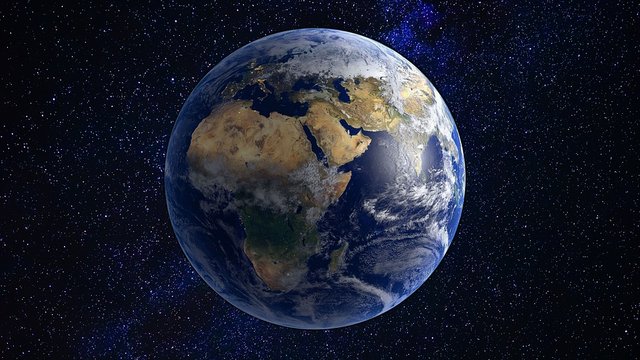Our Solar System - Earth #1
Our earth, since mankind can thinks it was been our home, our warming mother in the cold universe. The planet that is inseparably connected to the moon. And both are not easy to understand, although they are more or less within reach.
The earth is the largest rock planet in our solar system, all others are either smaller or gaseous like Jupiter. Nearly 150 million kilometers away from the sun, the earth moves once around our central star in 365 days, 9 minutes and 9.54 seconds. At the equator, the diameter is 12,756 kilometers and at the poles 12,713 kilometers. A day lasts 23 hours 56 minutes and 4.09 seconds. The mass is 5.97 times 10 to the power of 24 kilograms.
The atmosphere, which is about 640 kilometers thick, consists of 78 percent nitrogen, 21 percent oxygen and one percent noble gases. The surface consists of 70 percentage of water, the oceans.
Inside, the earth has a solid core which is between 5100 and 6371 kilometers thick and with 6700 degrees almost 1000 degrees hotter than the surface of the sun. It consists of almost 80 percent iron, followed by silicon, nickel, oxygen and sulfur. The core accounts for almost one third of the total earth mass. The outer liquid core with a thickness of 2900 to 5100 kilometers joins the inner core.
Then follows the lower mantle, 900 to 2100 kilometers, the upper mantle, 40 to 900 kilometers and finally the earth's crust, 50 to 100 kilometers. It is divided into smaller and larger tectonic plates, which float on the upper mantle and can interlock, the cause of earthquakes.
The temperature differences range from minus 89.6 degrees Celsius to plus 58 degrees. The blue sky is due to the high nitrogen content, because blue light is scattered about five times more strongly than red light. Only in the evening or in the morning, when the light of the sun shines flat, does the sky appear reddish or when there is a lot of dust in the air, because this breaks the red portion much more strongly.
From space, the earth appears blue, because the water of the oceans swallows the red light of the sun.


 Part 2
Part 2 

NASA - Space.com
Space Facts - Nine Planets
Lumen Learning
NorthernLights Centre - Aurora Service
Images: 1


Hi, @oendertuerk!
You just got a 1.17% upvote from SteemPlus!
To get higher upvotes, earn more SteemPlus Points (SPP). On your Steemit wallet, check your SPP balance and click on "How to earn SPP?" to find out all the ways to earn.
If you're not using SteemPlus yet, please check our last posts in here to see the many ways in which SteemPlus can improve your Steem experience on Steemit and Busy.
Hi @oendertuerk!
Your post was upvoted by @steem-ua, new Steem dApp, using UserAuthority for algorithmic post curation!
Your UA account score is currently 4.936 which ranks you at #1163 across all Steem accounts.
Your rank has improved 4 places in the last three days (old rank 1167).
In our last Algorithmic Curation Round, consisting of 161 contributions, your post is ranked at #25.
Evaluation of your UA score:
Feel free to join our @steem-ua Discord server